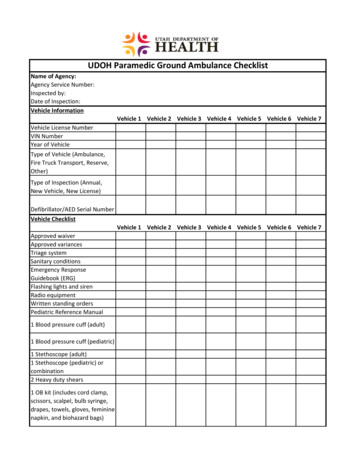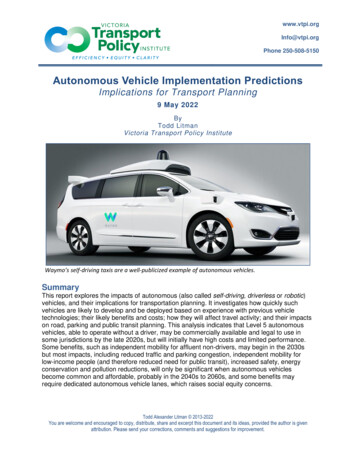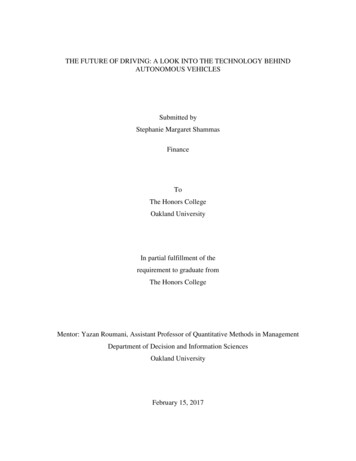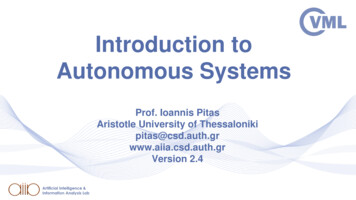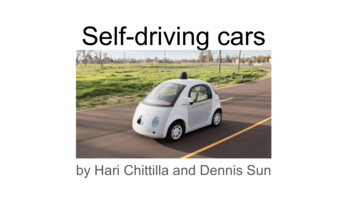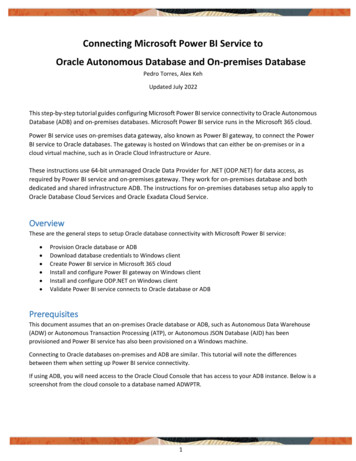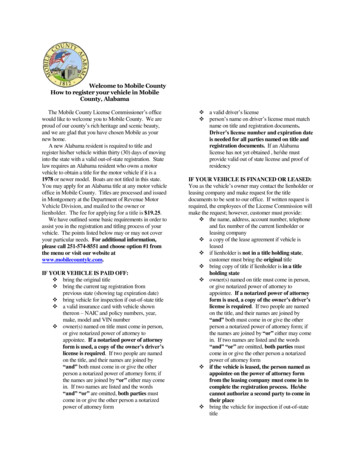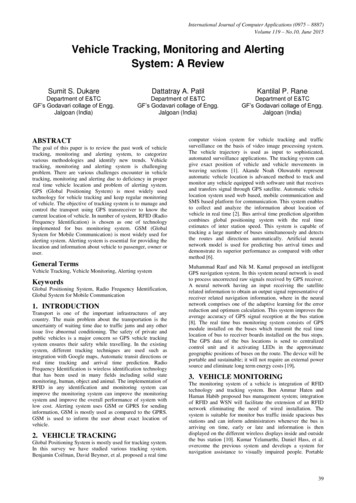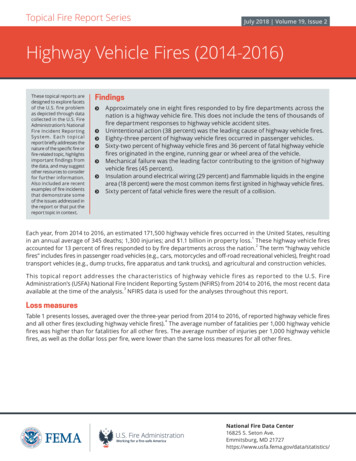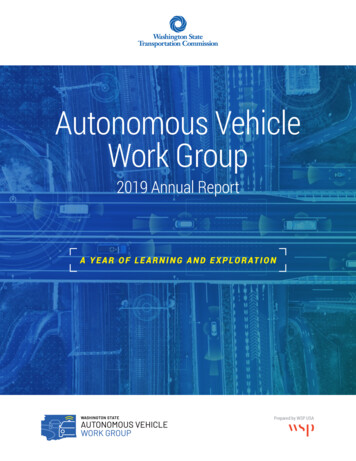
Transcription
Autonomous VehicleWork Group2019 Annual ReportA Y E A R O F L E A R N I N G A N D E X P L O R AT I O NPrepared by WSP USA
State of WashingtonTRANSPORTATION COMMISSIONPO Box 47308, Olympia WA 98504-7308 2404 Chandler Court SW, Suite 270, Olympia WA 98502(360) 705-7070 Fax (360) 705-6802 transc@wstc.wa.gov https://www.wstc.wa.govNovember 15, 2019Dear Governor Inslee, and Members of the Senate & House Transportation Committees:We are pleased to present to you the annual report for our state’s Autonomous Vehicle (AV)Work Group, created in the 2018 legislative session. RCW 47.01.510 requires theTransportation Commission to submit an annual report to the Governor and Legislaturedescribing the progress of the AV Work Group and the Commission’s recommendations.This report represents the culmination of extensive research, deliberation, and discussion in2019 led by a 34 members Executive Committee made up of public, private and non-profitorganizations, and seven subcommittees lead by nine different state agencies with theparticipation of nearly 500 stakeholders. The AV Work Group effort is truly a broad-based,transparent, and inclusive process with stakeholders and experts driving the research,assessment, and determination of what our state decision makers need to consider in order toprepare for the operation of AV’s on our public roadways in Washington State.AV’s are present in our state today. To date, twelve companies have self-certified with theDepartment of Licensing to test AV’s on our roadways. As private industry works to bringunprecedented technology to our world of mobility, the efforts of this Work Group helpsupport the achievement of public safety while encouraging innovation. This report sets forthsome beginning steps to accomplish this.We look forward to your review and input.Sincerely,Jerry Litt, ChairWashington State Transportation CommissionDarrin Grondel, ChairAutonomous Vehicle Work GroupExecutive Committee
Table of ContentsExecutive Summary. iii2019 in Review. iii2019 Work Group Accomplishments. iv2019 Recommendations. v1—Introduction. 1Industry Overview. 1Legislative Mandate. 12—The AV Work Group Curates Future Policy. 2Organizational Structure. 3Executive Committee. 4Subcommittees. 53—Looking Back at 2018 Recommendations. 6AV Work Group Website and Communications Plan. 6Clarification and Revision of Washington State Statutes. 6Conduct Public Education Campaign on Autonomous Vehicles. 7Conduct Health Impact Assessment (HIA). 84—2019: A Year of Much Learning and Fact Finding. 9Executive Committee. 9Impacts of AVs on Disabled and Disadvantaged CommunitiesAV-related Technologies Improving Traffic SafetyAutonomous Truck Testing and DeploymentWork Group Identification of Focus AreasSubcommittees Covered a Lot of Ground.10Infrastructure & Systems SubcommitteeLiability SubcommitteeLicensing SubcommitteeSafety SubcommitteeSystems Technology & Data Security SubcommitteeHealth & Equity SubcommitteeWorkforce Subcommittee5—Work Group Recommendations & Actions.17Policy Recommendations.182019 Annual Report i
5 Million Umbrella Liability Insurance for AV Testing CompaniesDevelop Policy Goals as part of a Washington State CAT Policy FrameworkDevelopment of a Statewide CAT Policy FrameworkConduct Assessment of Health ImpactsOperational Recommendations.21Establish new “Health & Equity” SubcommitteeEstablish new “Workforce” SubcommitteeAppoint disabilities rights representation to Executive CommitteeRecommendations Requiring Further Work.22AV Privacy and Data Security Principles and Data Standard6—The Work Continues.24Work Group Roadmap to 2023.24Work Group Website Launched.25ii Washington State Autonomous Vehicle Work Group
Executive Summary2019 in ReviewAutonomous vehicles (AVs) and related technologies are rapidlypenetrating the market, with lower-level automation becomingmainstream in newer vehicles today, and higher levels of automation being tested and deployed across the country. As of late2019, twelve companies had self-certified with the WashingtonState Department of Licensing their ability to safely test andoperate AVs on public roads in the state. To prepare for thisevolution in transportation, the Washington State TransportationCommission (WSTC) is carrying out requirements in current law(RCW 47.01.5101), which mandate the convening of an executiveand legislative Work Group to gather information and developAV policy recommendations to address the operation of AVs onpublic roadways in the State of Washington.The Work Group hit the ground running in 2019, with subcommittees actively meeting, developing and executing work plans,convening subgroups to explore topics in more detail, andengaging public and private leaders in each subcommittee’srespective focus areas to gain a broad understanding of thecurrent landscape and prioritize efforts moving forward.Several recommendations were cultivated and advanced throughthe Work Group’s process, including policy recommendationsneeding legislative action as well as operational changes to makethe Work Group itself more effective. These recommendationsfurther demonstrate the momentum gained by the Work Groupin 2019. More information on recommendations can be found inSection 5 of this report.The Work Group further expanded its knowledge of AVs and theirfar-reaching impacts through discussions and expert presentations. The Disabilities Rights Washington advocacy group andthe National Federation of the Blind addressed considerationsand potential impacts AVs will have on the disabled communities,pressing the importance of engaging these communities andthe concept of equity in AV policy conversations. The WorkGroup also learned more about advanced driver assistancesystems (ADAS), such as blind spot monitoring and rear collisionwarnings, and how these crash avoidance ADAS technologiesare reducing crashes and adjusting driver behavior for saferroadways.In 2019, 18 additional members were appointed to the ExecutiveCommittee, to ensure a broad range of perspectives and opinionsare at the table. These new representatives come from state andlocal government, transportation industry, academia, labor, andunderrepresented communities.Figure 1: Washington State Autonomous Vehicle Work Group StructureAV Work Group Executive CommitteeGovernment Representatives and Key Stakeholders from:GovernorFour members from SenateFour members from HouseInsurance CommissionerDOL DirectorWSDOT SecretaryWSP ChiefTraffic Safety Commission DirectorState Chief Information OfficerTransportation Commission MemberHealth SecretaryEmployment Security DirectorLabor & Industries DirectorData, Technology & AV TestingShared, Electric, TNC & TransitAutomakersLocal GovernmentsConsumers/Traveling PublicEnvironmentAcademicUnderrepresented yInfrastructure& SystemsSystem Tech &Data SecurityLiabilityHealth &EquityWorkforce2 Co-ChairsDOL Lead Agency2 Co-ChairsWTSC & WSPLead Agency2 Co-ChairsWSDOTLead Agency2 Co-ChairsState CIOLead Agency2 Co-ChairsInsurance Comm.Lead Agency2 Co-ChairsDOH Lead Agency2 Co-ChairsESD and L&ILead Agency1RCW 47.01.510 Autonomous Vehicle Executive and Legislative Work Group https://app.leg.wa.gov/RCW/default.aspx?cite 47.01.5102019 Annual Report iii
2019 Work Group AccomplishmentsMeetings between Januaryand October, 201918 additional membersappointed to ExecutiveCommittee 2 Executive Committee meetings 23 Subcommittee meetings 4 additional subcommittee meetingsscheduled in November & December State and Local Governments 18 Private Sector & Non-profitorganizations Academia2 New subcommitteesestablished Health & Equity Workforce 2Education: 13 expertpresentations Industry and technology overviews andcurrent progress National and state level regulations Legal considerations andrecommendationsRecommendations 4 policy recommendations made itthrough this year’s process (See Table 1) Public perception and educationopportunities Considerations for safety, insurance andlaw enforcementLaunched AV Work Groupwebsite Information on AV Work Group structure,priorities, Executive Committee andSubcommittees Education on AV-related initiativeshappening within the state Progress of AVs across the country inthe public and private sectors https://avworkgroupwa.org/iv Washington State Autonomous Vehicle Work Group
2019 RecommendationsAll recommendations brought forth by subcommittees and the Executive Committee are advanced to the WSTC. The WSTC, in turn,advances these recommendations to the Legislature and Governor via this annual report, regardless of the Executive Committee’s or theWSTC’s actions on the recommendations, as a matter of maintaining a complete public record of the process and results.To this end, provided below are all recommendations brought forth by the Work Group for the Legislature and Governor’s consideration,along with the actions taken by the Work Group’s Executive Committee and the WSTC.Table 1: Recommendations Advanced to the Executive Committee and WSTC for ee Action/RecommendationWSTC Action/RecommendationPOLICY RECOMMENDATIONSLiabilitysubcommitteeEnact legislation requiring self-certified (DOL) AV testingcompanies to maintain umbrella liability insurance no lessthan 5 million per occurrence for damages.EndorsedEndorsedInfrastructure& SystemssubcommitteeAdopt 8 policy goals to enable the Infrastructure & SystemsSubcommittee to continue work on the Washington StateDepartment of Transportation (WSDOT) CooperativeAutomated Transportation (CAT) Policy Framework and, as anext step, develop specific strategies.EndorsedEndorsedInfrastructure& SystemssubcommitteeEncourage the development of a statewide CAT/AVPolicy Framework that would integrate the WSDOT CATpolicy goals along with policy goals developed by othersubcommittees.EndorsedEndorsedHealth & EquitysubcommitteeConduct a Health Impact Assessment of AVs.No voting actionEndorsed**OPERATIONAL RECOMMENDATIONSSafety subcommitteeEstablish new “Health & Equity” Subcommittee.EndorsedWSTC CreatedExecutive CommitteeEstablish new “Workforce” Subcommittee.EndorsedWSTC CreatedExecutive CommitteeAppoint a disabilities rights representative to the ExecutiveCommittee.EndorsedWSTC AppointedRequestfurther explorationof best practices andstandardsAgreed withExecutiveCommittee actionRECOMMENDATIONS REQUIRING FURTHER WORKSystem Technology& Data SecuritysubcommitteeAdopt “AV Privacy and Data Security Principles” and “DataStandard revision 0.1” developed by the subcommittee.* Detailed information for each recommendation is included in Section 5 of this report.** Commission supports conducting this study with expectation that Health & Equity subcommittee will develop a detailed proposal.2019 Annual Report v
1—IntroductionIndustry OverviewWithin one generation, autonomous vehicles (AVs) went fromfuturistic fiction to an approaching reality, with lower-levelautomation becoming mainstream in newer vehicles today, andhigher levels of automation being tested across the country.As of late 2019, twelve companies had self-certified with theWashington Department of Licensing their ability to safely testand operate AVs on public roads in the state.This rapid market penetration of advancing technology isprompting all levels of government to consider current andpotential laws and policies to harness the benefits of thesetechnologies, while avoiding unintended consequences. TheState of Washington enacted legislation in 2018 creating theAV Work Group to cultivate a robust discussion on how best toprepare for the operation of AVs on public roadways, ensuringpublic safety while still encouraging innovation and advancementin mobility.Legislative MandateCurrent law (RCW 47.01.5101) directs the Washington StateTransportation Commission (WSTC) to appoint and convene anexecutive and legislative Work Group to gather information anddevelop AV policy recommendations to address the operation ofAVs on public roadways in the State of Washington. The WorkGroup and the WSTC are charged with the following: Following developments in AV technology and relatedpolicies. Exploring approaches to modify state policy, rules and lawsto further public safety and prepare for the emergence of AVtechnology.1 Sharing information on AV technology and policies withinterested stakeholders. The WSTC must develop and provide recommendationsbased upon the input from the Work Group and submit themalong with a progress report to the Governor and Legislatureby November 15th each year. This report fulfills the annualreporting requirement.The Washington State AV Work Group (hereafter referred to as“the Work Group”) first convened on June 27, 2018, and continues to explore opportunities and issues that AVs may present tothe health, safety, livability and economic viability to the Stateand its citizens. The legislation is in force through December 31,2023.RCW 47.01.510 Autonomous Vehicle Executive and Legislative Work Group https://app.leg.wa.gov/RCW/default.aspx?cite 47.01.5102019 Annual Report 1
2—The AV Work Group CuratesFuture PolicyThe Work Group is designed to be a tiered, bottom-upapproach where policy ideas are curated organically at thesubcommittee level, vetted by a diverse set of stakeholdersand interests, in a public forum that enables public participation as well. If advanced, the next stop is the ExecutiveCommittee, made up of a diverse set of public, private andnon-profit organizations. There, an idea is further vetted anddiscussed. Then it is on to the WSTC for final review anddiscussion. When an idea arrives at the Legislature’s doorstepin the form of a recommendation, it is the product of athorough, accessible and expert driven process.04 — Governor & Legislature03 — Transportation Commission02 — Executive Committee01— SubcommitteesThe roles and purpose of each level of the idea curationprocess is as follows:Level 1: Subcommittees Where ideas start and are developed Participation open to all Ideas are vetted - pros and cons identified Supported ideas sent to the Executive Committee Determines recommendations to endorse via a vote Reports outcome for all recommendations to the Governorand Legislature, along with WSTC’s position relative to eachrecommendation Works in partnership with lead state agencies & stakehold-ers to advocate for recommendations Lead agency and stakeholders advocate for recommenda-tions throughout processLevel 2: Executive Committee Comprised of public sector leaders and private sectorexpertsGroup Schedules hearings for presentation of recommendationsfrom the Commission & Work Group Schedules bills for hearing Reviews subcommittee recommendations, applying political, Considers funding needs via the budget process Determines recommendations to endorse via a vote Reports outcome for all recommendations to the WSTCLevel 3: Transportation Commission Considers all recommendations & assesses Subcommitteeand Executive Committee vote outcomes2 Receives report from Transportation Commission & Work Public forum for education and information sharingpublic, and private sector perspectives2Level 4: Governor and LegislatureWashington State Autonomous Vehicle Work Group website: https://avworkgroupwa.org/ Washington State Autonomous Vehicle Work Group Enacts laws and funds programs to achieve current lawintentThe Work Group is governed by self-created and adoptedpolicies and procedures for the Executive Committee andSubcommittees. They can be found on the Work Group website2
Organizational StructureIn order to ensure an inclusive, transparent and collaborative process, the Work Group is made up of an Executive Committee and sevensubcommittees, consisting of members from public and private stakeholders. The Executive Committee provides a forum for educationand information sharing among public sector leaders and private sector experts. The subcommittees hold publicly open discussions todevelop and vet ideas, fostering the ideas through to policy and operational recommendations. The organizational structure of the WorkGroup is explained in the figure below.Figure 2: Washington State Autonomous Vehicle Work Group StructureAV Work Group Executive CommitteeGovernment Representatives and Key Stakeholders from:GovernorFour members from SenateFour members from HouseInsurance CommissionerDOL DirectorWSDOT SecretaryWSP ChiefTraffic Safety Commission DirectorState Chief Information OfficerTransportation Commission MemberHealth SecretaryEmployment Security DirectorLabor & Industries DirectorData, Technology & AV TestingShared, Electric, TNC & TransitAutomakersLocal GovernmentsConsumers/Traveling PublicEnvironmentAcademicUnderrepresented yInfrastructure& SystemsSystem Tech &Data Security2 Co-ChairsDOL Lead Agency2 Co-ChairsWTSC & WSP Lead Agency2 Co-ChairsWSDOT Lead Agency2 Co-ChairsState CIO Lead AgencyGeneral jurisdiction(now–2023 sunset):General jurisdiction(now–2023 sunset):Manufacturer Vehicle TestingPilot certificationVehicle registrationDriver’s licensingRules of the roadGeneral jurisdiction(now–2023 sunset):Traffic safetyLaw enforcementSynchronization with othersafety prioritiesTraffic incident managementGeneral jurisdiction(now–2023 sunset):Roadway infrastructureTraffic managementTransit service & vehiclesAdvertisingRight of wayMulti-modal transportationMobility as a serviceData & information managementCybersecurityPrivacy protectionLiabilityHealth & EquityWorkforce2 Co-ChairsInsurance Comm. Lead Agency2 Co-ChairsDOH Lead Agency2 Co-ChairsESD and L&I Lead AgencyGeneral jurisdiction(now–2023 sunset):InsuranceTort liabilityCriminal lawJudiciaryGeneral jurisdiction(now–2023 sunset):Health and equityconsiderations related toautonomous vehicles, such asair quality, water quality, noise,green space, mental well-being,physical activity, safety, andsocial connectionsGeneral jurisdiction(now–2023 sunset):Worker safety & worker rightsWorker displacement/job lossWorker retraining and transitionIndustry impactsEngagement fromcommunities, prioritizingcommunities of color2019 Annual Report 3
Executive CommitteeThe Executive Committee is comprised of thought leaders, applying political, public, non-profit, and private sector perspectives on ideasand recommendations. Current law establishes the Executive Committee membership, allowing additional members to be appointed bythe WSTC as needed. The current membership of the Executive Committee is listed below.Table 2: Executive Committee MembershipName and TitleOrganizationLEGISLATIVELY APPOINTED MEMBERSDarrin Grondel, Work Group Chair and Executive DirectorWashington Traffic Safety CommissionJames A. Restucci, Work Group Vice-Chair and CommissionerWashington State Transportation CommissionSenator Curtis KingWashington State LegislatureSenator Ann RiversWashington State LegislatureSenator Joe NguyenWashington State LegislatureSenator Mona DasWashington State LegislatureRepresentative Zack HudginsWashington State LegislatureRepresentative Shelley KlobaWashington State LegislatureRepresentative Matt SheaWashington State LegislatureRepresentative Matt BoehnkeWashington State LegislatureJohn Batiste, ChiefWashington State PatrolMike Kreidler, Insurance CommissionerOffice of the Insurance CommissionerTeresa Berntsen, DirectorDepartment of LicensingRoger Millar, SecretaryDepartment of TransportationCharles Knutson, Senior Policy AdvisorGovernor’s OfficeMEMBERS ADDED BY WSTC4Joel Sacks, DirectorDepartment of Labor & IndustriesJohn Wiesman, SecretaryDepartment of HealthSuzan LeVine, CommissionerEmployment Security DepartmentWill Saunders, Interim Chief Privacy OfficerOffice of the Chief Information OfficerDr. Yinhai Wang, DirectorUniversity of Washington STAR LabJustin Leighton, Executive DirectorWashington State Transit AssociationTom Alberg, Co-ChairACES NorthwestSam Zimbabwe, DirectorCity of Seattle Transportation DepartmentJosh Fisher, Government Affairs Senior ManagerAssociation of Global AutomakersBrenda Wiest, Legislative DirectorTeamsters Local 117Todd O’Brien, Public Works DirectorAdams CountyJessica Ramirez, Director of Community EngagementPuget Sound SageBryan Mistele, CEOINRIXJohn Milbrath, VP Member ServicesAAABryce Yadon, State Policy DirectorFuturewiseCaleb Weaver, Director of West Coast Public AffairsUberSteve Gordon, CEOGordon TruckingMufaddal Ezzy, Waymo, Head of Public Policy for Western U.S.Mufaddal Ezzy, Waymo, Head of Public Policy for Western U.S.Anna Zivarts, Disability Rights Washington, Director of Rooted in RightsAnna Zivarts, Disability Rights Washington, Director of Rooted in Rights Washington State Autonomous Vehicle Work Group
SubcommitteesIdeas and recommendations emerge from subcommittees, where a diverse set of subject matter experts conduct research, gatherinformation, and discuss challenges and opportunities of AVs and related technologies. Subcommittees provide an opportunity fora broad range of perspectives to be applied to ideas as they are explored and potentially fostered into formal policy or operationalrecommendations. Key attributes of the subcommittees are: Each subcommittee is administered and supported by the state agencies who have jurisdiction over the subcommittee topical area(e.g. Dept. of Licensing administers and supports the Licensing Subcommittee). Each subcommittee is co-chaired by one public and one private sector representative. All meetings are noticed and open to the general public for participation. Subcommittee meeting agendas, notes and presentations are published on the Work Group website. The subcommittees, co-chairsand administering agency(ies) are listed below.Table 3: Subcommittee LeadershipSubcommitteePublic Sector Co-ChairPrivate Sector Co-ChairAdministering Lead Agency(ies)Health & EquityDr. Andrew Dannenberg(University of Washington)Yet to be DeterminedWashington State Department ofHealth (DOH)Infrastructure & SystemsRoger Millar (WSDOT)Mike Ennis (Association ofWashington Business)Washington State Department ofTransportation (WSDOT)WorkforceNick Streuli (ESD)Brenda Weist (Teamsters)Washington State EmploymentSecurity (ESD) and WashingtonState Department of Labor &Industries (L&I)Maggie Leland (L&I)LiabilityLonnie Johns-Brown (OIC)Harris Clarke (PEMCO)Office of the InsuranceCommissioner (OIC)LicensingBeau Perschbacher (DOL)Drew Wilder (VicariousLiability Risk Mgt. LLC)Department of Licensing (DOL)SafetyCaptain Tom Foster* (WSP)Kenton Brine** (NW InsuranceCouncil)Washington Traffic SafetyCommission (WTSC) andWashington State Patrol (WSP)System Technology andData SecurityWill Saunders (OCIO)Michael Schutzler (WashingtonTechnology IndustryAssociation)Office of the Chief InformationOfficer (OCIO)*Captain Dan Hall (WSP) served as Co-Chair through October 2019**Outgoing as of October 20192019 Annual Report 5
3—Looking Back at 2018RecommendationsIn 2018, the AV Work Group and the WSTC made three policy recommendations to the Legislature and Governor, via the 2018 AnnualAV Work Group Report formally submitted on January 11, 2019. This section summarizes the recommendations and outcome of thoserecommendations.AV Work Group Website and Communications PlanRecommended by:Executive CommitteeRecommendation:Develop and implement a communications strategy and plan, and launch a stand-alone website for the Work Group. Thewebsite will establish a one-stop shop for the public and stakeholders to get information on AVs in the State, as well as WorkGroup activities. This recommendation included a funding request of 190,000.Executive Committee Action:Advanced recommendation to the WSTC for consideration.WSTC Action:Advanced recommendation as proposed to the Legislature for consideration.Outcome and Current Status: The recommendation was accepted by the Legislature and the WSTC was appropriated 100,000 to establish an AV WorkGroup website. The website has now been launched: AV Work Group website3. (See section 6, p.25 under Work GroupWebsite Launched for more information.) The WSTC, in consultation with the Work Group, will be developing a communications plan.Clarification and Revision of Washington State StatutesRecommended by:University of Washington School of Law, presented directly to the Work Group Executive CommitteeRecommendation:Clarify and potentially revise current Washington State statutes and policies and coordinate with federal rules and progress toaddress legal considerations of AVs. Preempt local regulation: Prevent unnecessary roadblocks to deployment of autonomous vehicles.36Washington State Autonomous Vehicle Work Group website: https://avworkgroupwa.org/ Washington State Autonomous Vehicle Work Group
Update definitions: Revise the RCW to accommodate new technologies. Self-Certification: Promote innovation and freedom to develop new technologies. Enhanced Infrastructure: Encourage local, state and federal improvements in road systems and technologies to supportAVs. Control Liability: Impose liability on AV systems and manufacturers while autonomous systems are in operation. Update current data security laws: “Lead the pack” in securing driver and user data.Executive Committee Action:No formal voting action taken.WSTC Action:Requires further evaluation by the Executive Committee and Subcommittees.Outcome and Current Status: The recommendation language was provided to each subcommittee for further review and refinement. The University of Washington School of Law presented to multiple subcommittees during 2019 to provide information onthe recommendations and the school’s activities related to the recommendations. The School of Law noted that 2019/20 school year students will be evaluating the recommendation language andrevising based on further research on industry progress and best practices, as well as other states’ and federal activity onthe subject. The School of Law anticipates a revised set of recommendations will be presented to the Work Group by Spring 2
Within one generation, autonomous vehicles (AVs) went from futuristic fiction to an approaching reality, with lower-level automation becoming mainstream in newer vehicles today, and higher levels of automation being tested across the country. As of late 2019, twelve companies had self-certified with the

